Impact of Colonization on Indigenous Australians: An Analysis
VerifiedAdded on 2021/05/30
|12
|2947
|255
Essay
AI Summary
This essay critically analyzes the colonization of Australia from both the British colonizers' and the indigenous inhabitants' perspectives. It examines the British motives, including establishing a perfect colony, deporting criminals, spreading British reach, civilizing the world, and acquiring new territory. The essay highlights the devastating impact on the Aboriginal population, including displacement, resource competition, the introduction of new diseases, and the destruction of their traditional way of life. The colonization, while strategically beneficial for the British, led to the near wipe-out of the native population and their culture. Desklib provides access to similar essays and study resources for students.
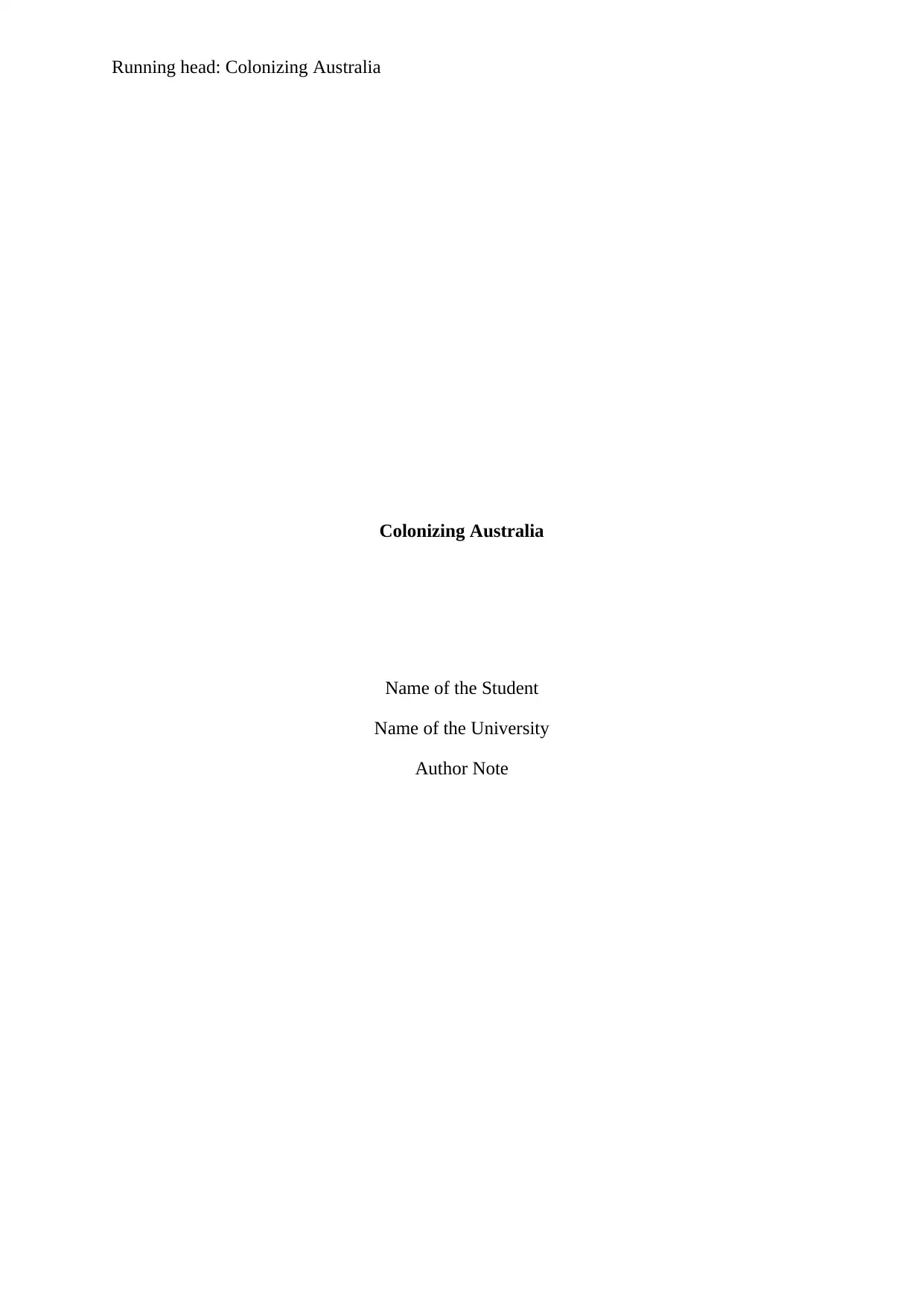
Running head: Colonizing Australia
Colonizing Australia
Name of the Student
Name of the University
Author Note
Colonizing Australia
Name of the Student
Name of the University
Author Note
Paraphrase This Document
Need a fresh take? Get an instant paraphrase of this document with our AI Paraphraser
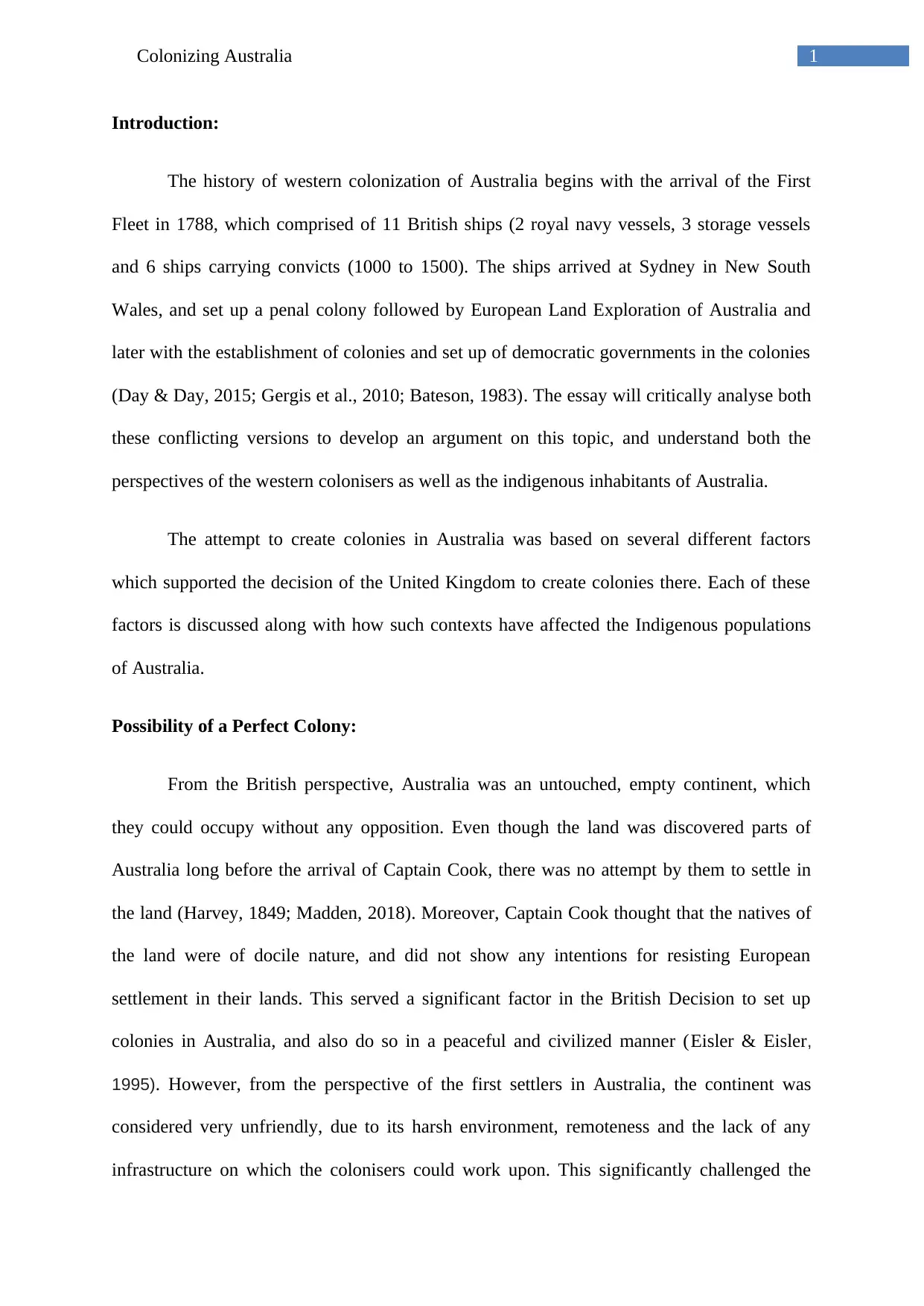
1Colonizing Australia
Introduction:
The history of western colonization of Australia begins with the arrival of the First
Fleet in 1788, which comprised of 11 British ships (2 royal navy vessels, 3 storage vessels
and 6 ships carrying convicts (1000 to 1500). The ships arrived at Sydney in New South
Wales, and set up a penal colony followed by European Land Exploration of Australia and
later with the establishment of colonies and set up of democratic governments in the colonies
(Day & Day, 2015; Gergis et al., 2010; Bateson, 1983). The essay will critically analyse both
these conflicting versions to develop an argument on this topic, and understand both the
perspectives of the western colonisers as well as the indigenous inhabitants of Australia.
The attempt to create colonies in Australia was based on several different factors
which supported the decision of the United Kingdom to create colonies there. Each of these
factors is discussed along with how such contexts have affected the Indigenous populations
of Australia.
Possibility of a Perfect Colony:
From the British perspective, Australia was an untouched, empty continent, which
they could occupy without any opposition. Even though the land was discovered parts of
Australia long before the arrival of Captain Cook, there was no attempt by them to settle in
the land (Harvey, 1849; Madden, 2018). Moreover, Captain Cook thought that the natives of
the land were of docile nature, and did not show any intentions for resisting European
settlement in their lands. This served a significant factor in the British Decision to set up
colonies in Australia, and also do so in a peaceful and civilized manner (Eisler & Eisler,
1995). However, from the perspective of the first settlers in Australia, the continent was
considered very unfriendly, due to its harsh environment, remoteness and the lack of any
infrastructure on which the colonisers could work upon. This significantly challenged the
Introduction:
The history of western colonization of Australia begins with the arrival of the First
Fleet in 1788, which comprised of 11 British ships (2 royal navy vessels, 3 storage vessels
and 6 ships carrying convicts (1000 to 1500). The ships arrived at Sydney in New South
Wales, and set up a penal colony followed by European Land Exploration of Australia and
later with the establishment of colonies and set up of democratic governments in the colonies
(Day & Day, 2015; Gergis et al., 2010; Bateson, 1983). The essay will critically analyse both
these conflicting versions to develop an argument on this topic, and understand both the
perspectives of the western colonisers as well as the indigenous inhabitants of Australia.
The attempt to create colonies in Australia was based on several different factors
which supported the decision of the United Kingdom to create colonies there. Each of these
factors is discussed along with how such contexts have affected the Indigenous populations
of Australia.
Possibility of a Perfect Colony:
From the British perspective, Australia was an untouched, empty continent, which
they could occupy without any opposition. Even though the land was discovered parts of
Australia long before the arrival of Captain Cook, there was no attempt by them to settle in
the land (Harvey, 1849; Madden, 2018). Moreover, Captain Cook thought that the natives of
the land were of docile nature, and did not show any intentions for resisting European
settlement in their lands. This served a significant factor in the British Decision to set up
colonies in Australia, and also do so in a peaceful and civilized manner (Eisler & Eisler,
1995). However, from the perspective of the first settlers in Australia, the continent was
considered very unfriendly, due to its harsh environment, remoteness and the lack of any
infrastructure on which the colonisers could work upon. This significantly challenged the
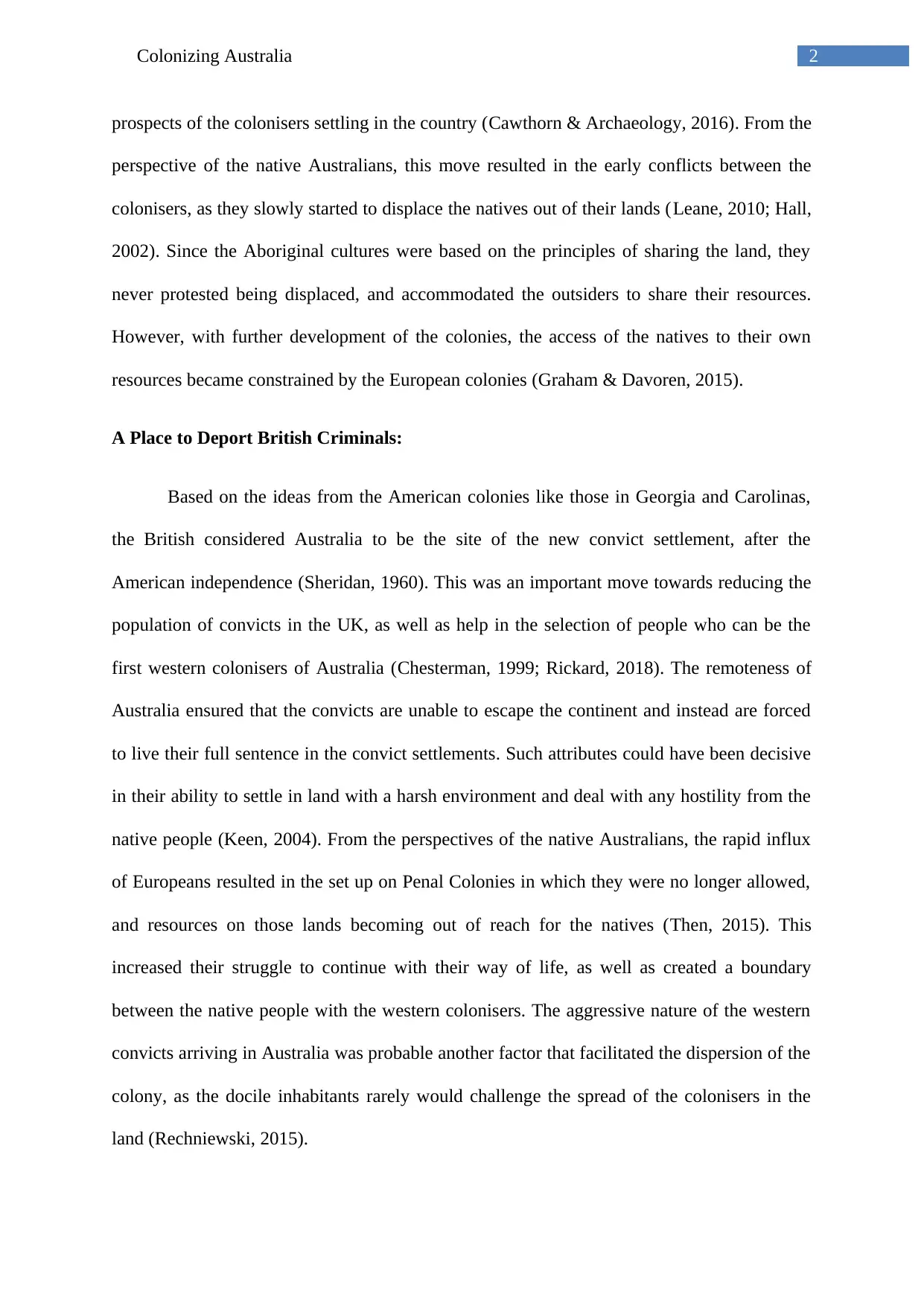
2Colonizing Australia
prospects of the colonisers settling in the country (Cawthorn & Archaeology, 2016). From the
perspective of the native Australians, this move resulted in the early conflicts between the
colonisers, as they slowly started to displace the natives out of their lands (Leane, 2010; Hall,
2002). Since the Aboriginal cultures were based on the principles of sharing the land, they
never protested being displaced, and accommodated the outsiders to share their resources.
However, with further development of the colonies, the access of the natives to their own
resources became constrained by the European colonies (Graham & Davoren, 2015).
A Place to Deport British Criminals:
Based on the ideas from the American colonies like those in Georgia and Carolinas,
the British considered Australia to be the site of the new convict settlement, after the
American independence (Sheridan, 1960). This was an important move towards reducing the
population of convicts in the UK, as well as help in the selection of people who can be the
first western colonisers of Australia (Chesterman, 1999; Rickard, 2018). The remoteness of
Australia ensured that the convicts are unable to escape the continent and instead are forced
to live their full sentence in the convict settlements. Such attributes could have been decisive
in their ability to settle in land with a harsh environment and deal with any hostility from the
native people (Keen, 2004). From the perspectives of the native Australians, the rapid influx
of Europeans resulted in the set up on Penal Colonies in which they were no longer allowed,
and resources on those lands becoming out of reach for the natives (Then, 2015). This
increased their struggle to continue with their way of life, as well as created a boundary
between the native people with the western colonisers. The aggressive nature of the western
convicts arriving in Australia was probable another factor that facilitated the dispersion of the
colony, as the docile inhabitants rarely would challenge the spread of the colonisers in the
land (Rechniewski, 2015).
prospects of the colonisers settling in the country (Cawthorn & Archaeology, 2016). From the
perspective of the native Australians, this move resulted in the early conflicts between the
colonisers, as they slowly started to displace the natives out of their lands (Leane, 2010; Hall,
2002). Since the Aboriginal cultures were based on the principles of sharing the land, they
never protested being displaced, and accommodated the outsiders to share their resources.
However, with further development of the colonies, the access of the natives to their own
resources became constrained by the European colonies (Graham & Davoren, 2015).
A Place to Deport British Criminals:
Based on the ideas from the American colonies like those in Georgia and Carolinas,
the British considered Australia to be the site of the new convict settlement, after the
American independence (Sheridan, 1960). This was an important move towards reducing the
population of convicts in the UK, as well as help in the selection of people who can be the
first western colonisers of Australia (Chesterman, 1999; Rickard, 2018). The remoteness of
Australia ensured that the convicts are unable to escape the continent and instead are forced
to live their full sentence in the convict settlements. Such attributes could have been decisive
in their ability to settle in land with a harsh environment and deal with any hostility from the
native people (Keen, 2004). From the perspectives of the native Australians, the rapid influx
of Europeans resulted in the set up on Penal Colonies in which they were no longer allowed,
and resources on those lands becoming out of reach for the natives (Then, 2015). This
increased their struggle to continue with their way of life, as well as created a boundary
between the native people with the western colonisers. The aggressive nature of the western
convicts arriving in Australia was probable another factor that facilitated the dispersion of the
colony, as the docile inhabitants rarely would challenge the spread of the colonisers in the
land (Rechniewski, 2015).
⊘ This is a preview!⊘
Do you want full access?
Subscribe today to unlock all pages.

Trusted by 1+ million students worldwide
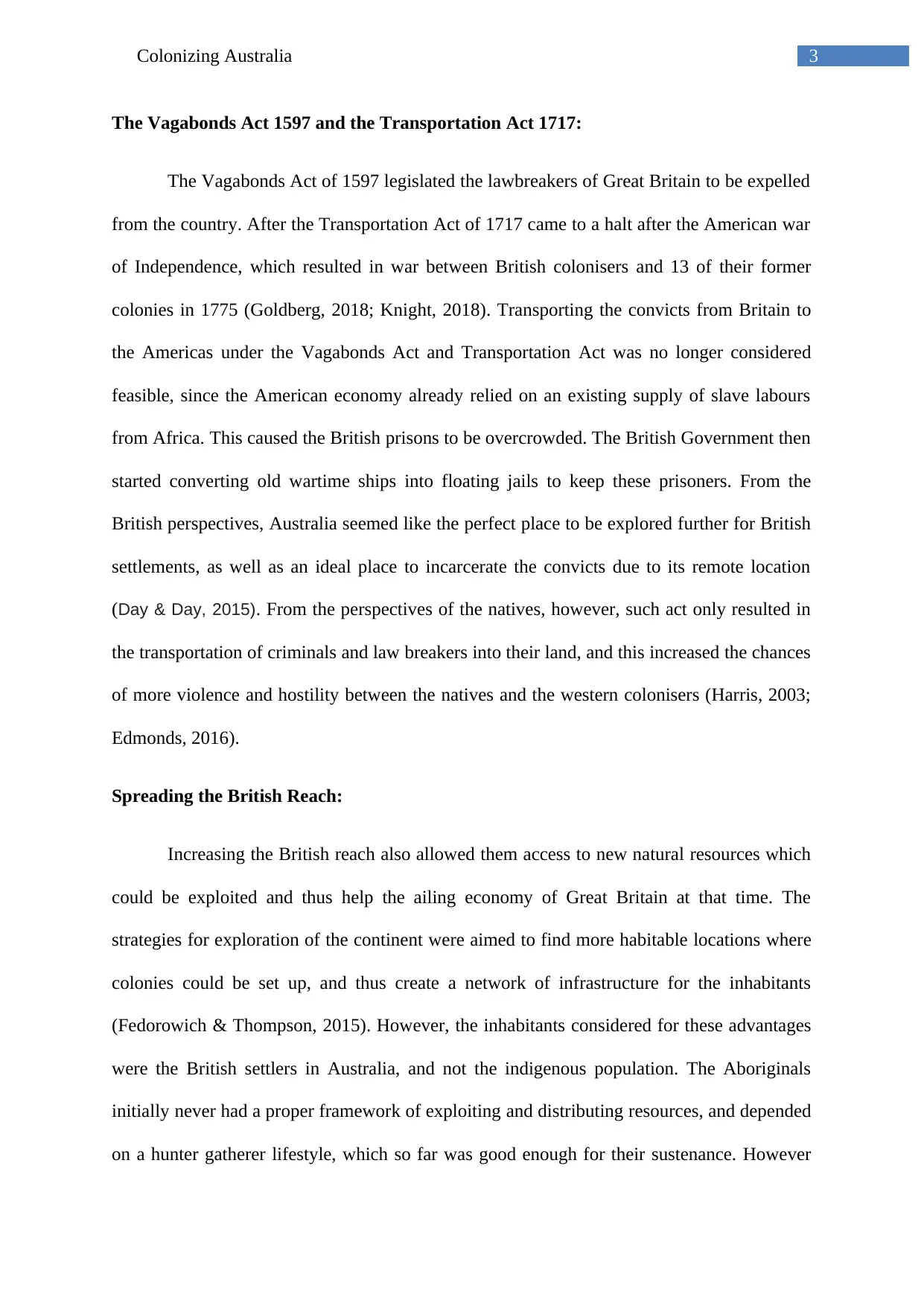
3Colonizing Australia
The Vagabonds Act 1597 and the Transportation Act 1717:
The Vagabonds Act of 1597 legislated the lawbreakers of Great Britain to be expelled
from the country. After the Transportation Act of 1717 came to a halt after the American war
of Independence, which resulted in war between British colonisers and 13 of their former
colonies in 1775 (Goldberg, 2018; Knight, 2018). Transporting the convicts from Britain to
the Americas under the Vagabonds Act and Transportation Act was no longer considered
feasible, since the American economy already relied on an existing supply of slave labours
from Africa. This caused the British prisons to be overcrowded. The British Government then
started converting old wartime ships into floating jails to keep these prisoners. From the
British perspectives, Australia seemed like the perfect place to be explored further for British
settlements, as well as an ideal place to incarcerate the convicts due to its remote location
(Day & Day, 2015). From the perspectives of the natives, however, such act only resulted in
the transportation of criminals and law breakers into their land, and this increased the chances
of more violence and hostility between the natives and the western colonisers (Harris, 2003;
Edmonds, 2016).
Spreading the British Reach:
Increasing the British reach also allowed them access to new natural resources which
could be exploited and thus help the ailing economy of Great Britain at that time. The
strategies for exploration of the continent were aimed to find more habitable locations where
colonies could be set up, and thus create a network of infrastructure for the inhabitants
(Fedorowich & Thompson, 2015). However, the inhabitants considered for these advantages
were the British settlers in Australia, and not the indigenous population. The Aboriginals
initially never had a proper framework of exploiting and distributing resources, and depended
on a hunter gatherer lifestyle, which so far was good enough for their sustenance. However
The Vagabonds Act 1597 and the Transportation Act 1717:
The Vagabonds Act of 1597 legislated the lawbreakers of Great Britain to be expelled
from the country. After the Transportation Act of 1717 came to a halt after the American war
of Independence, which resulted in war between British colonisers and 13 of their former
colonies in 1775 (Goldberg, 2018; Knight, 2018). Transporting the convicts from Britain to
the Americas under the Vagabonds Act and Transportation Act was no longer considered
feasible, since the American economy already relied on an existing supply of slave labours
from Africa. This caused the British prisons to be overcrowded. The British Government then
started converting old wartime ships into floating jails to keep these prisoners. From the
British perspectives, Australia seemed like the perfect place to be explored further for British
settlements, as well as an ideal place to incarcerate the convicts due to its remote location
(Day & Day, 2015). From the perspectives of the natives, however, such act only resulted in
the transportation of criminals and law breakers into their land, and this increased the chances
of more violence and hostility between the natives and the western colonisers (Harris, 2003;
Edmonds, 2016).
Spreading the British Reach:
Increasing the British reach also allowed them access to new natural resources which
could be exploited and thus help the ailing economy of Great Britain at that time. The
strategies for exploration of the continent were aimed to find more habitable locations where
colonies could be set up, and thus create a network of infrastructure for the inhabitants
(Fedorowich & Thompson, 2015). However, the inhabitants considered for these advantages
were the British settlers in Australia, and not the indigenous population. The Aboriginals
initially never had a proper framework of exploiting and distributing resources, and depended
on a hunter gatherer lifestyle, which so far was good enough for their sustenance. However
Paraphrase This Document
Need a fresh take? Get an instant paraphrase of this document with our AI Paraphraser
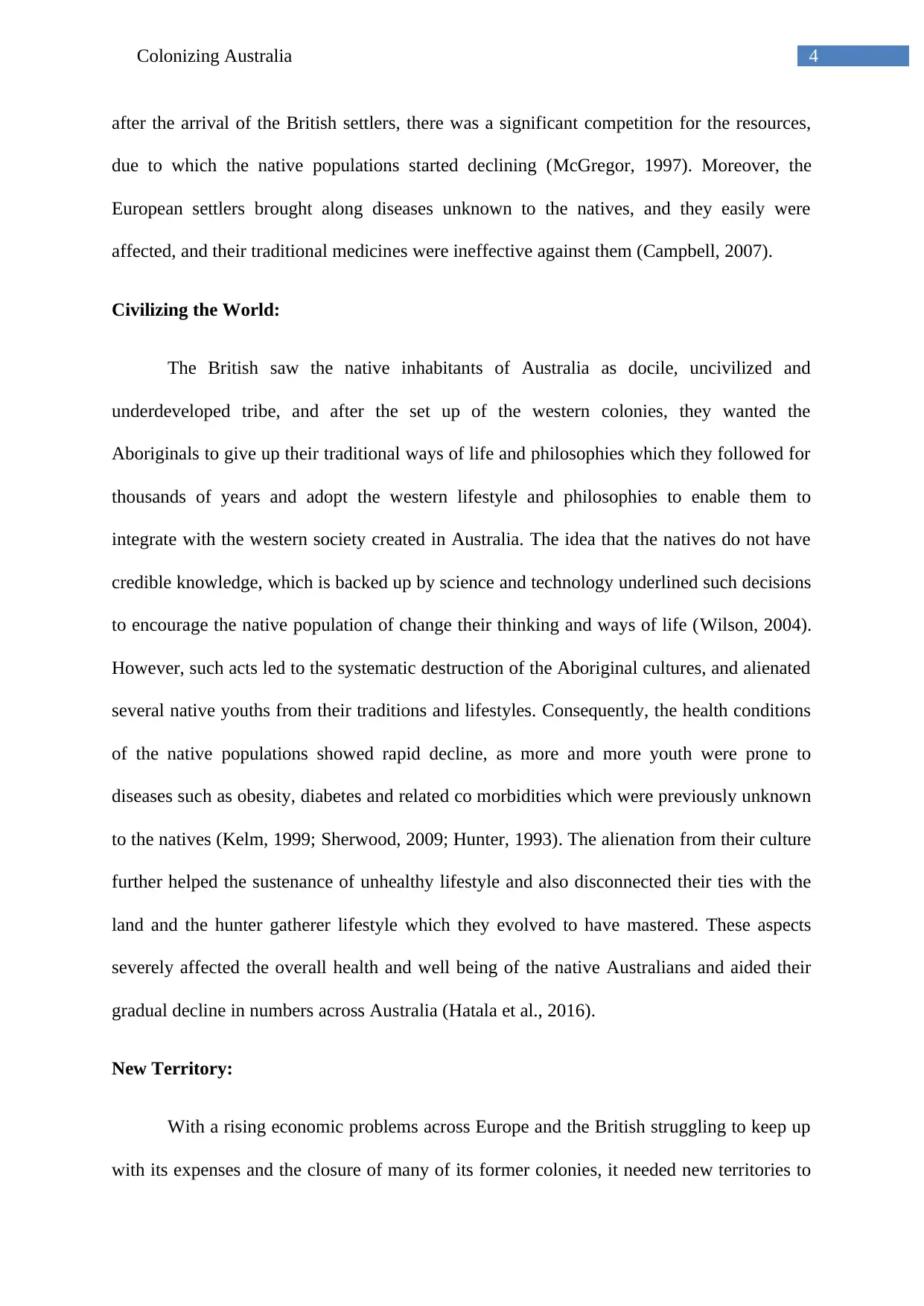
4Colonizing Australia
after the arrival of the British settlers, there was a significant competition for the resources,
due to which the native populations started declining (McGregor, 1997). Moreover, the
European settlers brought along diseases unknown to the natives, and they easily were
affected, and their traditional medicines were ineffective against them (Campbell, 2007).
Civilizing the World:
The British saw the native inhabitants of Australia as docile, uncivilized and
underdeveloped tribe, and after the set up of the western colonies, they wanted the
Aboriginals to give up their traditional ways of life and philosophies which they followed for
thousands of years and adopt the western lifestyle and philosophies to enable them to
integrate with the western society created in Australia. The idea that the natives do not have
credible knowledge, which is backed up by science and technology underlined such decisions
to encourage the native population of change their thinking and ways of life (Wilson, 2004).
However, such acts led to the systematic destruction of the Aboriginal cultures, and alienated
several native youths from their traditions and lifestyles. Consequently, the health conditions
of the native populations showed rapid decline, as more and more youth were prone to
diseases such as obesity, diabetes and related co morbidities which were previously unknown
to the natives (Kelm, 1999; Sherwood, 2009; Hunter, 1993). The alienation from their culture
further helped the sustenance of unhealthy lifestyle and also disconnected their ties with the
land and the hunter gatherer lifestyle which they evolved to have mastered. These aspects
severely affected the overall health and well being of the native Australians and aided their
gradual decline in numbers across Australia (Hatala et al., 2016).
New Territory:
With a rising economic problems across Europe and the British struggling to keep up
with its expenses and the closure of many of its former colonies, it needed new territories to
after the arrival of the British settlers, there was a significant competition for the resources,
due to which the native populations started declining (McGregor, 1997). Moreover, the
European settlers brought along diseases unknown to the natives, and they easily were
affected, and their traditional medicines were ineffective against them (Campbell, 2007).
Civilizing the World:
The British saw the native inhabitants of Australia as docile, uncivilized and
underdeveloped tribe, and after the set up of the western colonies, they wanted the
Aboriginals to give up their traditional ways of life and philosophies which they followed for
thousands of years and adopt the western lifestyle and philosophies to enable them to
integrate with the western society created in Australia. The idea that the natives do not have
credible knowledge, which is backed up by science and technology underlined such decisions
to encourage the native population of change their thinking and ways of life (Wilson, 2004).
However, such acts led to the systematic destruction of the Aboriginal cultures, and alienated
several native youths from their traditions and lifestyles. Consequently, the health conditions
of the native populations showed rapid decline, as more and more youth were prone to
diseases such as obesity, diabetes and related co morbidities which were previously unknown
to the natives (Kelm, 1999; Sherwood, 2009; Hunter, 1993). The alienation from their culture
further helped the sustenance of unhealthy lifestyle and also disconnected their ties with the
land and the hunter gatherer lifestyle which they evolved to have mastered. These aspects
severely affected the overall health and well being of the native Australians and aided their
gradual decline in numbers across Australia (Hatala et al., 2016).
New Territory:
With a rising economic problems across Europe and the British struggling to keep up
with its expenses and the closure of many of its former colonies, it needed new territories to
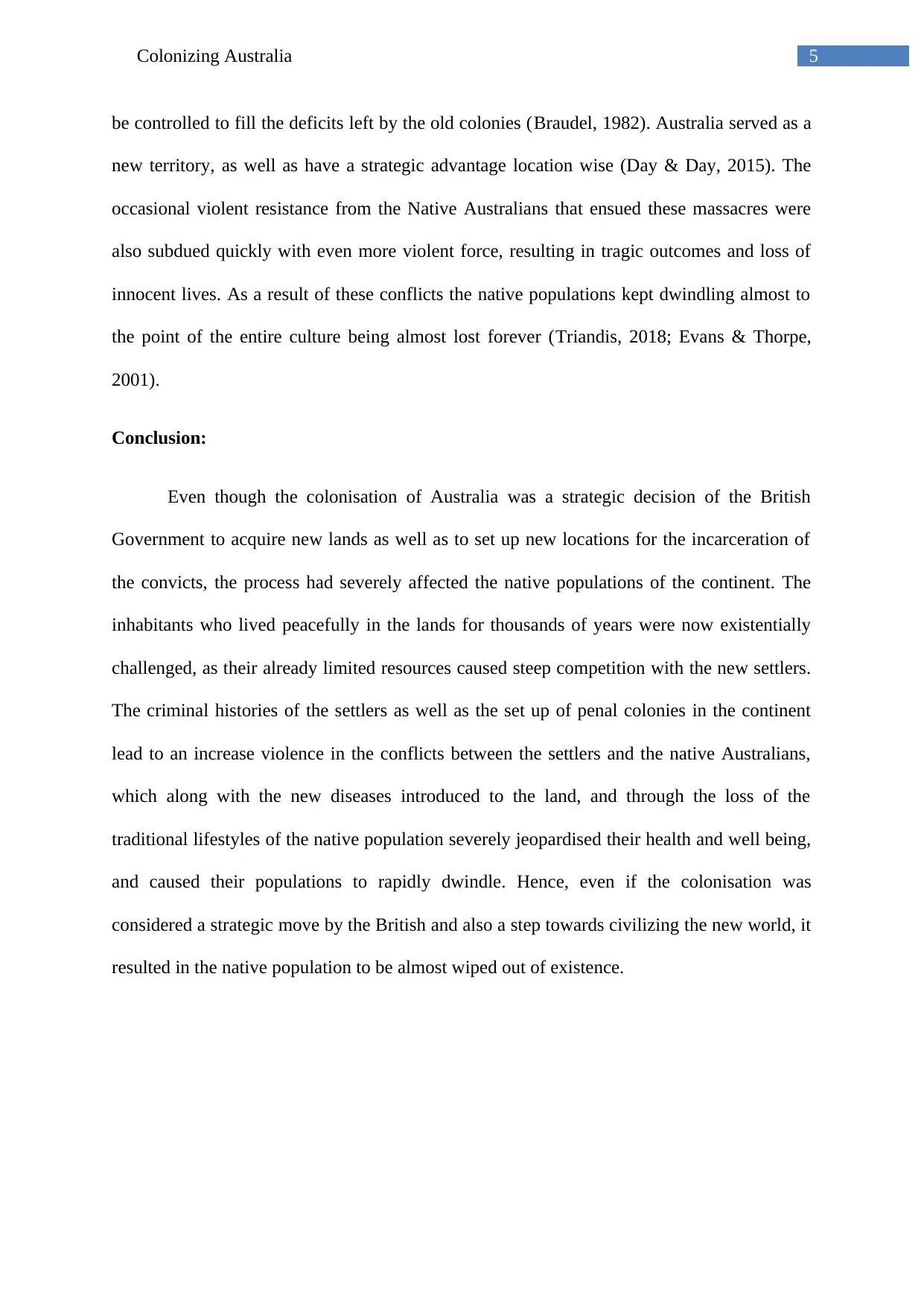
5Colonizing Australia
be controlled to fill the deficits left by the old colonies (Braudel, 1982). Australia served as a
new territory, as well as have a strategic advantage location wise (Day & Day, 2015). The
occasional violent resistance from the Native Australians that ensued these massacres were
also subdued quickly with even more violent force, resulting in tragic outcomes and loss of
innocent lives. As a result of these conflicts the native populations kept dwindling almost to
the point of the entire culture being almost lost forever (Triandis, 2018; Evans & Thorpe,
2001).
Conclusion:
Even though the colonisation of Australia was a strategic decision of the British
Government to acquire new lands as well as to set up new locations for the incarceration of
the convicts, the process had severely affected the native populations of the continent. The
inhabitants who lived peacefully in the lands for thousands of years were now existentially
challenged, as their already limited resources caused steep competition with the new settlers.
The criminal histories of the settlers as well as the set up of penal colonies in the continent
lead to an increase violence in the conflicts between the settlers and the native Australians,
which along with the new diseases introduced to the land, and through the loss of the
traditional lifestyles of the native population severely jeopardised their health and well being,
and caused their populations to rapidly dwindle. Hence, even if the colonisation was
considered a strategic move by the British and also a step towards civilizing the new world, it
resulted in the native population to be almost wiped out of existence.
be controlled to fill the deficits left by the old colonies (Braudel, 1982). Australia served as a
new territory, as well as have a strategic advantage location wise (Day & Day, 2015). The
occasional violent resistance from the Native Australians that ensued these massacres were
also subdued quickly with even more violent force, resulting in tragic outcomes and loss of
innocent lives. As a result of these conflicts the native populations kept dwindling almost to
the point of the entire culture being almost lost forever (Triandis, 2018; Evans & Thorpe,
2001).
Conclusion:
Even though the colonisation of Australia was a strategic decision of the British
Government to acquire new lands as well as to set up new locations for the incarceration of
the convicts, the process had severely affected the native populations of the continent. The
inhabitants who lived peacefully in the lands for thousands of years were now existentially
challenged, as their already limited resources caused steep competition with the new settlers.
The criminal histories of the settlers as well as the set up of penal colonies in the continent
lead to an increase violence in the conflicts between the settlers and the native Australians,
which along with the new diseases introduced to the land, and through the loss of the
traditional lifestyles of the native population severely jeopardised their health and well being,
and caused their populations to rapidly dwindle. Hence, even if the colonisation was
considered a strategic move by the British and also a step towards civilizing the new world, it
resulted in the native population to be almost wiped out of existence.
⊘ This is a preview!⊘
Do you want full access?
Subscribe today to unlock all pages.

Trusted by 1+ million students worldwide
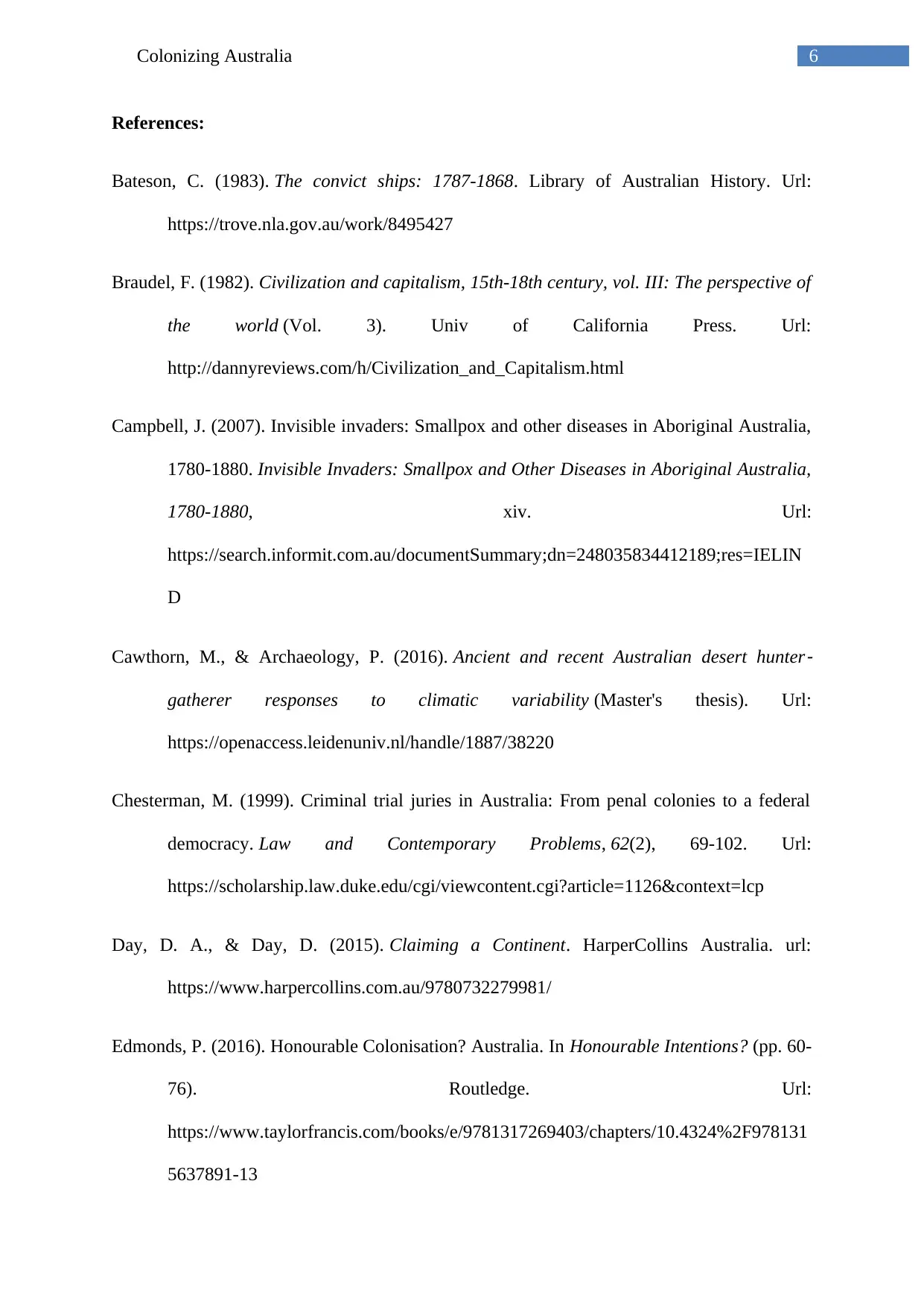
6Colonizing Australia
References:
Bateson, C. (1983). The convict ships: 1787-1868. Library of Australian History. Url:
https://trove.nla.gov.au/work/8495427
Braudel, F. (1982). Civilization and capitalism, 15th-18th century, vol. III: The perspective of
the world (Vol. 3). Univ of California Press. Url:
http://dannyreviews.com/h/Civilization_and_Capitalism.html
Campbell, J. (2007). Invisible invaders: Smallpox and other diseases in Aboriginal Australia,
1780-1880. Invisible Invaders: Smallpox and Other Diseases in Aboriginal Australia,
1780-1880, xiv. Url:
https://search.informit.com.au/documentSummary;dn=248035834412189;res=IELIN
D
Cawthorn, M., & Archaeology, P. (2016). Ancient and recent Australian desert hunter
‐
gatherer responses to climatic variability (Master's thesis). Url:
https://openaccess.leidenuniv.nl/handle/1887/38220
Chesterman, M. (1999). Criminal trial juries in Australia: From penal colonies to a federal
democracy. Law and Contemporary Problems, 62(2), 69-102. Url:
https://scholarship.law.duke.edu/cgi/viewcontent.cgi?article=1126&context=lcp
Day, D. A., & Day, D. (2015). Claiming a Continent. HarperCollins Australia. url:
https://www.harpercollins.com.au/9780732279981/
Edmonds, P. (2016). Honourable Colonisation? Australia. In Honourable Intentions? (pp. 60-
76). Routledge. Url:
https://www.taylorfrancis.com/books/e/9781317269403/chapters/10.4324%2F978131
5637891-13
References:
Bateson, C. (1983). The convict ships: 1787-1868. Library of Australian History. Url:
https://trove.nla.gov.au/work/8495427
Braudel, F. (1982). Civilization and capitalism, 15th-18th century, vol. III: The perspective of
the world (Vol. 3). Univ of California Press. Url:
http://dannyreviews.com/h/Civilization_and_Capitalism.html
Campbell, J. (2007). Invisible invaders: Smallpox and other diseases in Aboriginal Australia,
1780-1880. Invisible Invaders: Smallpox and Other Diseases in Aboriginal Australia,
1780-1880, xiv. Url:
https://search.informit.com.au/documentSummary;dn=248035834412189;res=IELIN
D
Cawthorn, M., & Archaeology, P. (2016). Ancient and recent Australian desert hunter
‐
gatherer responses to climatic variability (Master's thesis). Url:
https://openaccess.leidenuniv.nl/handle/1887/38220
Chesterman, M. (1999). Criminal trial juries in Australia: From penal colonies to a federal
democracy. Law and Contemporary Problems, 62(2), 69-102. Url:
https://scholarship.law.duke.edu/cgi/viewcontent.cgi?article=1126&context=lcp
Day, D. A., & Day, D. (2015). Claiming a Continent. HarperCollins Australia. url:
https://www.harpercollins.com.au/9780732279981/
Edmonds, P. (2016). Honourable Colonisation? Australia. In Honourable Intentions? (pp. 60-
76). Routledge. Url:
https://www.taylorfrancis.com/books/e/9781317269403/chapters/10.4324%2F978131
5637891-13
Paraphrase This Document
Need a fresh take? Get an instant paraphrase of this document with our AI Paraphraser
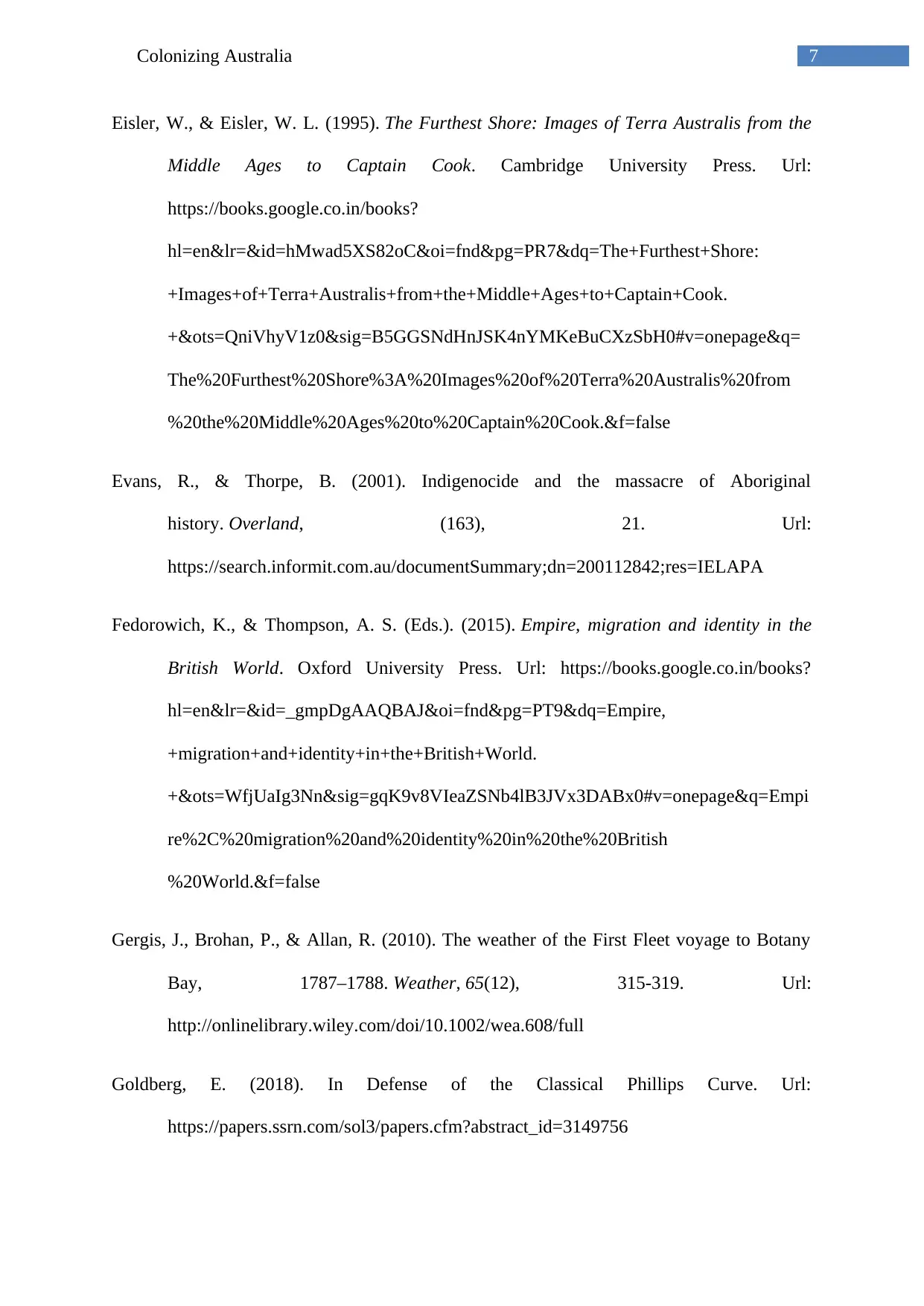
7Colonizing Australia
Eisler, W., & Eisler, W. L. (1995). The Furthest Shore: Images of Terra Australis from the
Middle Ages to Captain Cook. Cambridge University Press. Url:
https://books.google.co.in/books?
hl=en&lr=&id=hMwad5XS82oC&oi=fnd&pg=PR7&dq=The+Furthest+Shore:
+Images+of+Terra+Australis+from+the+Middle+Ages+to+Captain+Cook.
+&ots=QniVhyV1z0&sig=B5GGSNdHnJSK4nYMKeBuCXzSbH0#v=onepage&q=
The%20Furthest%20Shore%3A%20Images%20of%20Terra%20Australis%20from
%20the%20Middle%20Ages%20to%20Captain%20Cook.&f=false
Evans, R., & Thorpe, B. (2001). Indigenocide and the massacre of Aboriginal
history. Overland, (163), 21. Url:
https://search.informit.com.au/documentSummary;dn=200112842;res=IELAPA
Fedorowich, K., & Thompson, A. S. (Eds.). (2015). Empire, migration and identity in the
British World. Oxford University Press. Url: https://books.google.co.in/books?
hl=en&lr=&id=_gmpDgAAQBAJ&oi=fnd&pg=PT9&dq=Empire,
+migration+and+identity+in+the+British+World.
+&ots=WfjUaIg3Nn&sig=gqK9v8VIeaZSNb4lB3JVx3DABx0#v=onepage&q=Empi
re%2C%20migration%20and%20identity%20in%20the%20British
%20World.&f=false
Gergis, J., Brohan, P., & Allan, R. (2010). The weather of the First Fleet voyage to Botany
Bay, 1787–1788. Weather, 65(12), 315-319. Url:
http://onlinelibrary.wiley.com/doi/10.1002/wea.608/full
Goldberg, E. (2018). In Defense of the Classical Phillips Curve. Url:
https://papers.ssrn.com/sol3/papers.cfm?abstract_id=3149756
Eisler, W., & Eisler, W. L. (1995). The Furthest Shore: Images of Terra Australis from the
Middle Ages to Captain Cook. Cambridge University Press. Url:
https://books.google.co.in/books?
hl=en&lr=&id=hMwad5XS82oC&oi=fnd&pg=PR7&dq=The+Furthest+Shore:
+Images+of+Terra+Australis+from+the+Middle+Ages+to+Captain+Cook.
+&ots=QniVhyV1z0&sig=B5GGSNdHnJSK4nYMKeBuCXzSbH0#v=onepage&q=
The%20Furthest%20Shore%3A%20Images%20of%20Terra%20Australis%20from
%20the%20Middle%20Ages%20to%20Captain%20Cook.&f=false
Evans, R., & Thorpe, B. (2001). Indigenocide and the massacre of Aboriginal
history. Overland, (163), 21. Url:
https://search.informit.com.au/documentSummary;dn=200112842;res=IELAPA
Fedorowich, K., & Thompson, A. S. (Eds.). (2015). Empire, migration and identity in the
British World. Oxford University Press. Url: https://books.google.co.in/books?
hl=en&lr=&id=_gmpDgAAQBAJ&oi=fnd&pg=PT9&dq=Empire,
+migration+and+identity+in+the+British+World.
+&ots=WfjUaIg3Nn&sig=gqK9v8VIeaZSNb4lB3JVx3DABx0#v=onepage&q=Empi
re%2C%20migration%20and%20identity%20in%20the%20British
%20World.&f=false
Gergis, J., Brohan, P., & Allan, R. (2010). The weather of the First Fleet voyage to Botany
Bay, 1787–1788. Weather, 65(12), 315-319. Url:
http://onlinelibrary.wiley.com/doi/10.1002/wea.608/full
Goldberg, E. (2018). In Defense of the Classical Phillips Curve. Url:
https://papers.ssrn.com/sol3/papers.cfm?abstract_id=3149756
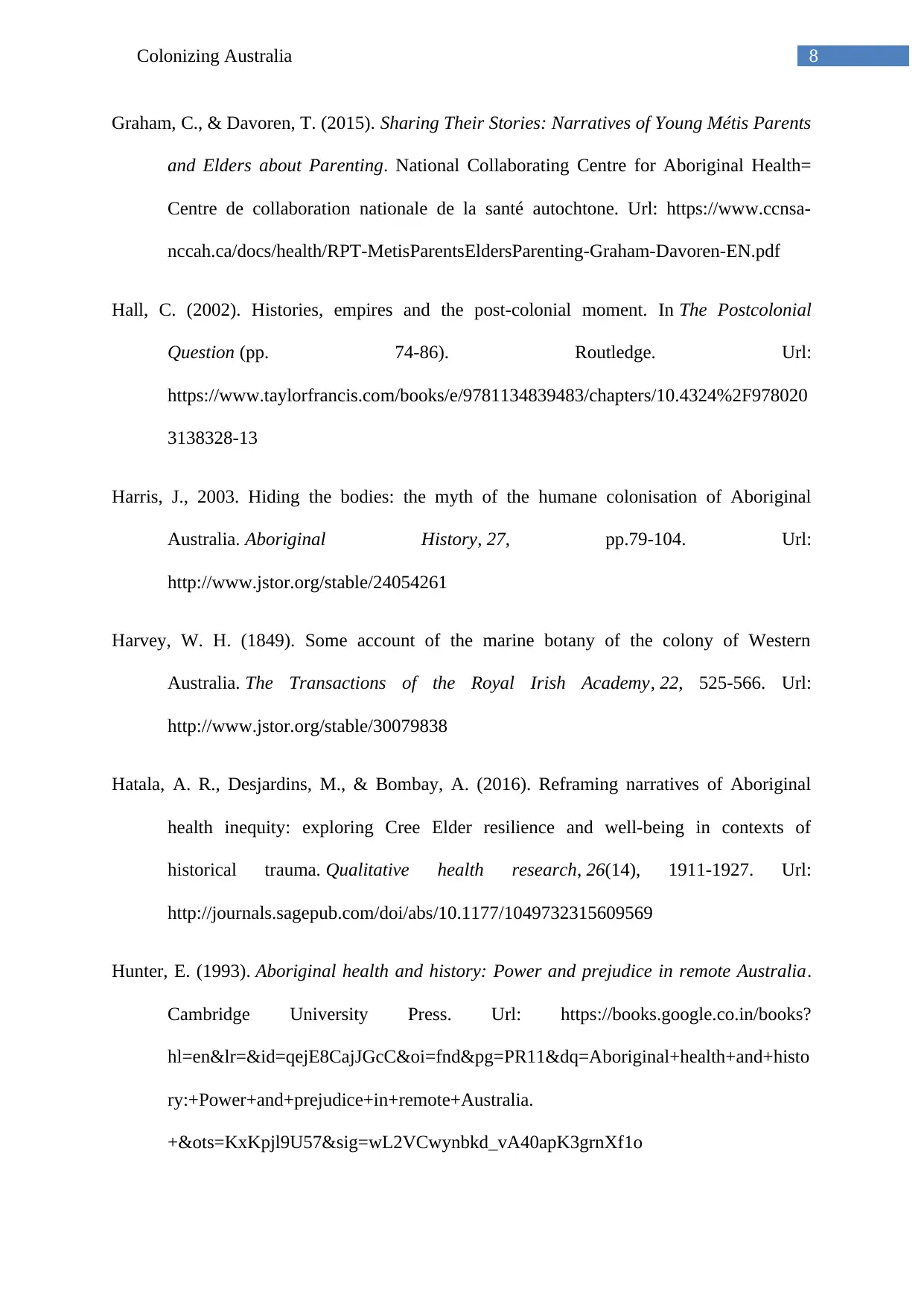
8Colonizing Australia
Graham, C., & Davoren, T. (2015). Sharing Their Stories: Narratives of Young Métis Parents
and Elders about Parenting. National Collaborating Centre for Aboriginal Health=
Centre de collaboration nationale de la santé autochtone. Url: https://www.ccnsa-
nccah.ca/docs/health/RPT-MetisParentsEldersParenting-Graham-Davoren-EN.pdf
Hall, C. (2002). Histories, empires and the post-colonial moment. In The Postcolonial
Question (pp. 74-86). Routledge. Url:
https://www.taylorfrancis.com/books/e/9781134839483/chapters/10.4324%2F978020
3138328-13
Harris, J., 2003. Hiding the bodies: the myth of the humane colonisation of Aboriginal
Australia. Aboriginal History, 27, pp.79-104. Url:
http://www.jstor.org/stable/24054261
Harvey, W. H. (1849). Some account of the marine botany of the colony of Western
Australia. The Transactions of the Royal Irish Academy, 22, 525-566. Url:
http://www.jstor.org/stable/30079838
Hatala, A. R., Desjardins, M., & Bombay, A. (2016). Reframing narratives of Aboriginal
health inequity: exploring Cree Elder resilience and well-being in contexts of
historical trauma. Qualitative health research, 26(14), 1911-1927. Url:
http://journals.sagepub.com/doi/abs/10.1177/1049732315609569
Hunter, E. (1993). Aboriginal health and history: Power and prejudice in remote Australia.
Cambridge University Press. Url: https://books.google.co.in/books?
hl=en&lr=&id=qejE8CajJGcC&oi=fnd&pg=PR11&dq=Aboriginal+health+and+histo
ry:+Power+and+prejudice+in+remote+Australia.
+&ots=KxKpjl9U57&sig=wL2VCwynbkd_vA40apK3grnXf1o
Graham, C., & Davoren, T. (2015). Sharing Their Stories: Narratives of Young Métis Parents
and Elders about Parenting. National Collaborating Centre for Aboriginal Health=
Centre de collaboration nationale de la santé autochtone. Url: https://www.ccnsa-
nccah.ca/docs/health/RPT-MetisParentsEldersParenting-Graham-Davoren-EN.pdf
Hall, C. (2002). Histories, empires and the post-colonial moment. In The Postcolonial
Question (pp. 74-86). Routledge. Url:
https://www.taylorfrancis.com/books/e/9781134839483/chapters/10.4324%2F978020
3138328-13
Harris, J., 2003. Hiding the bodies: the myth of the humane colonisation of Aboriginal
Australia. Aboriginal History, 27, pp.79-104. Url:
http://www.jstor.org/stable/24054261
Harvey, W. H. (1849). Some account of the marine botany of the colony of Western
Australia. The Transactions of the Royal Irish Academy, 22, 525-566. Url:
http://www.jstor.org/stable/30079838
Hatala, A. R., Desjardins, M., & Bombay, A. (2016). Reframing narratives of Aboriginal
health inequity: exploring Cree Elder resilience and well-being in contexts of
historical trauma. Qualitative health research, 26(14), 1911-1927. Url:
http://journals.sagepub.com/doi/abs/10.1177/1049732315609569
Hunter, E. (1993). Aboriginal health and history: Power and prejudice in remote Australia.
Cambridge University Press. Url: https://books.google.co.in/books?
hl=en&lr=&id=qejE8CajJGcC&oi=fnd&pg=PR11&dq=Aboriginal+health+and+histo
ry:+Power+and+prejudice+in+remote+Australia.
+&ots=KxKpjl9U57&sig=wL2VCwynbkd_vA40apK3grnXf1o
⊘ This is a preview!⊘
Do you want full access?
Subscribe today to unlock all pages.

Trusted by 1+ million students worldwide
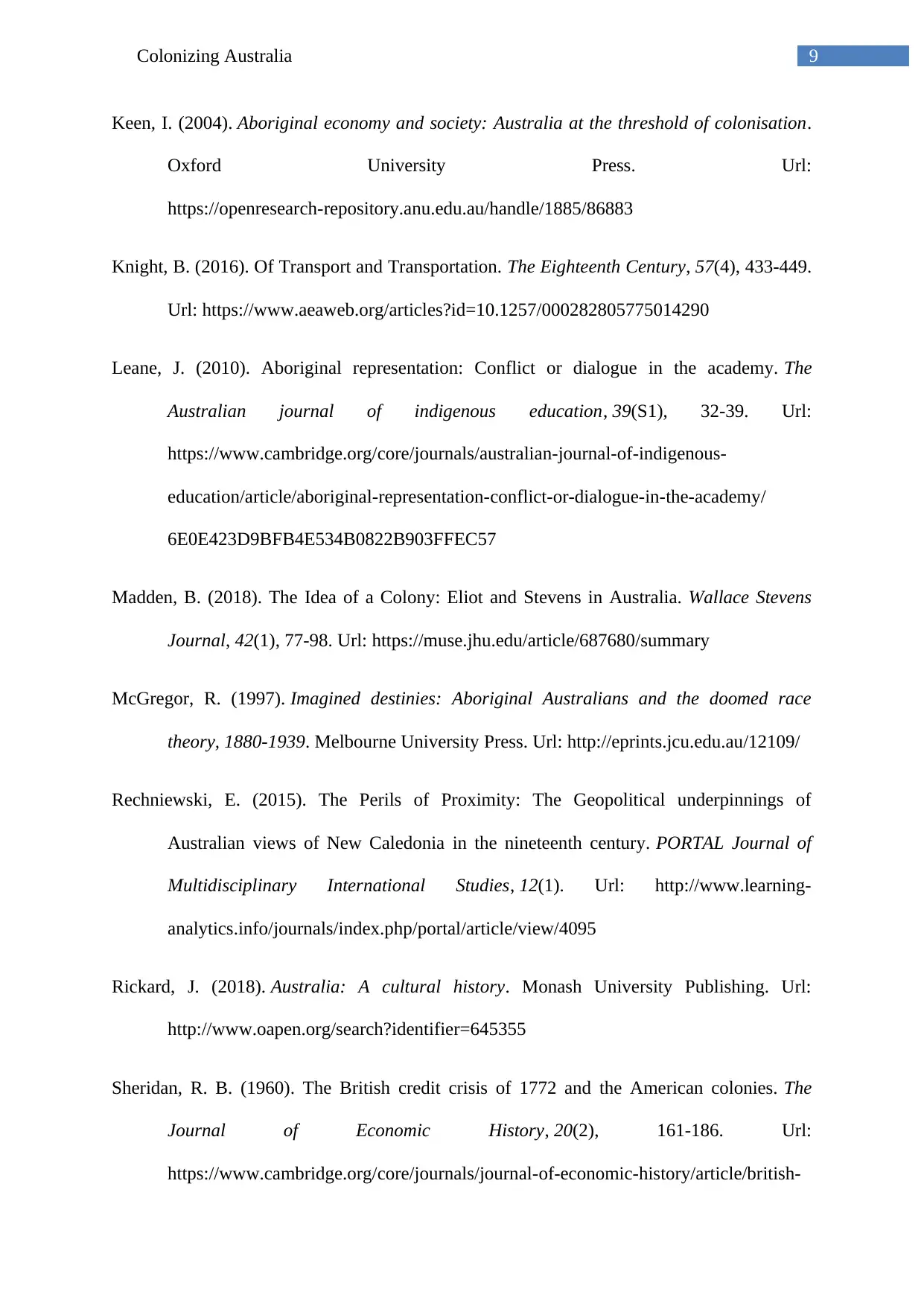
9Colonizing Australia
Keen, I. (2004). Aboriginal economy and society: Australia at the threshold of colonisation.
Oxford University Press. Url:
https://openresearch-repository.anu.edu.au/handle/1885/86883
Knight, B. (2016). Of Transport and Transportation. The Eighteenth Century, 57(4), 433-449.
Url: https://www.aeaweb.org/articles?id=10.1257/000282805775014290
Leane, J. (2010). Aboriginal representation: Conflict or dialogue in the academy. The
Australian journal of indigenous education, 39(S1), 32-39. Url:
https://www.cambridge.org/core/journals/australian-journal-of-indigenous-
education/article/aboriginal-representation-conflict-or-dialogue-in-the-academy/
6E0E423D9BFB4E534B0822B903FFEC57
Madden, B. (2018). The Idea of a Colony: Eliot and Stevens in Australia. Wallace Stevens
Journal, 42(1), 77-98. Url: https://muse.jhu.edu/article/687680/summary
McGregor, R. (1997). Imagined destinies: Aboriginal Australians and the doomed race
theory, 1880-1939. Melbourne University Press. Url: http://eprints.jcu.edu.au/12109/
Rechniewski, E. (2015). The Perils of Proximity: The Geopolitical underpinnings of
Australian views of New Caledonia in the nineteenth century. PORTAL Journal of
Multidisciplinary International Studies, 12(1). Url: http://www.learning-
analytics.info/journals/index.php/portal/article/view/4095
Rickard, J. (2018). Australia: A cultural history. Monash University Publishing. Url:
http://www.oapen.org/search?identifier=645355
Sheridan, R. B. (1960). The British credit crisis of 1772 and the American colonies. The
Journal of Economic History, 20(2), 161-186. Url:
https://www.cambridge.org/core/journals/journal-of-economic-history/article/british-
Keen, I. (2004). Aboriginal economy and society: Australia at the threshold of colonisation.
Oxford University Press. Url:
https://openresearch-repository.anu.edu.au/handle/1885/86883
Knight, B. (2016). Of Transport and Transportation. The Eighteenth Century, 57(4), 433-449.
Url: https://www.aeaweb.org/articles?id=10.1257/000282805775014290
Leane, J. (2010). Aboriginal representation: Conflict or dialogue in the academy. The
Australian journal of indigenous education, 39(S1), 32-39. Url:
https://www.cambridge.org/core/journals/australian-journal-of-indigenous-
education/article/aboriginal-representation-conflict-or-dialogue-in-the-academy/
6E0E423D9BFB4E534B0822B903FFEC57
Madden, B. (2018). The Idea of a Colony: Eliot and Stevens in Australia. Wallace Stevens
Journal, 42(1), 77-98. Url: https://muse.jhu.edu/article/687680/summary
McGregor, R. (1997). Imagined destinies: Aboriginal Australians and the doomed race
theory, 1880-1939. Melbourne University Press. Url: http://eprints.jcu.edu.au/12109/
Rechniewski, E. (2015). The Perils of Proximity: The Geopolitical underpinnings of
Australian views of New Caledonia in the nineteenth century. PORTAL Journal of
Multidisciplinary International Studies, 12(1). Url: http://www.learning-
analytics.info/journals/index.php/portal/article/view/4095
Rickard, J. (2018). Australia: A cultural history. Monash University Publishing. Url:
http://www.oapen.org/search?identifier=645355
Sheridan, R. B. (1960). The British credit crisis of 1772 and the American colonies. The
Journal of Economic History, 20(2), 161-186. Url:
https://www.cambridge.org/core/journals/journal-of-economic-history/article/british-
Paraphrase This Document
Need a fresh take? Get an instant paraphrase of this document with our AI Paraphraser
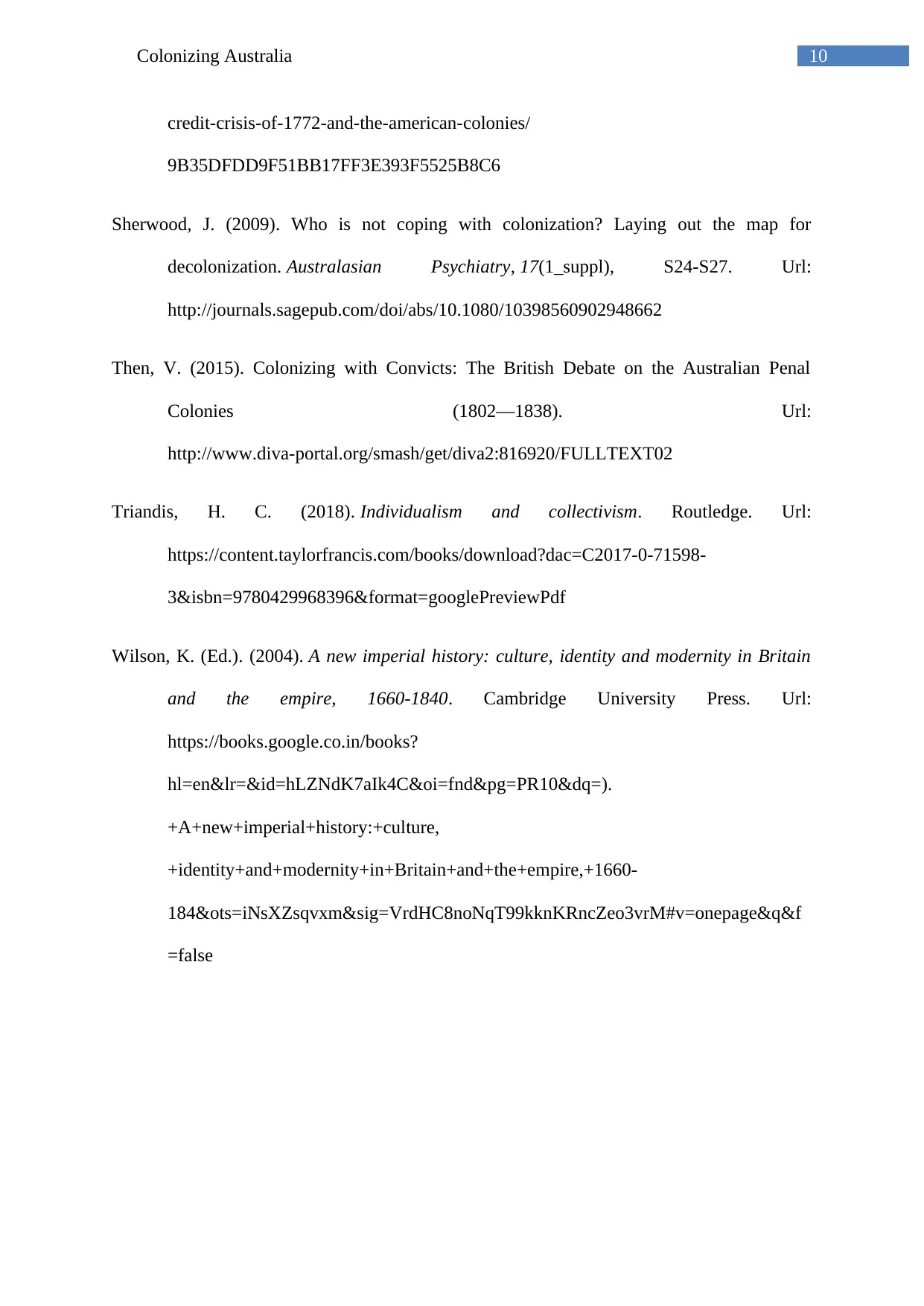
10Colonizing Australia
credit-crisis-of-1772-and-the-american-colonies/
9B35DFDD9F51BB17FF3E393F5525B8C6
Sherwood, J. (2009). Who is not coping with colonization? Laying out the map for
decolonization. Australasian Psychiatry, 17(1_suppl), S24-S27. Url:
http://journals.sagepub.com/doi/abs/10.1080/10398560902948662
Then, V. (2015). Colonizing with Convicts: The British Debate on the Australian Penal
Colonies (1802—1838). Url:
http://www.diva-portal.org/smash/get/diva2:816920/FULLTEXT02
Triandis, H. C. (2018). Individualism and collectivism. Routledge. Url:
https://content.taylorfrancis.com/books/download?dac=C2017-0-71598-
3&isbn=9780429968396&format=googlePreviewPdf
Wilson, K. (Ed.). (2004). A new imperial history: culture, identity and modernity in Britain
and the empire, 1660-1840. Cambridge University Press. Url:
https://books.google.co.in/books?
hl=en&lr=&id=hLZNdK7aIk4C&oi=fnd&pg=PR10&dq=).
+A+new+imperial+history:+culture,
+identity+and+modernity+in+Britain+and+the+empire,+1660-
184&ots=iNsXZsqvxm&sig=VrdHC8noNqT99kknKRncZeo3vrM#v=onepage&q&f
=false
credit-crisis-of-1772-and-the-american-colonies/
9B35DFDD9F51BB17FF3E393F5525B8C6
Sherwood, J. (2009). Who is not coping with colonization? Laying out the map for
decolonization. Australasian Psychiatry, 17(1_suppl), S24-S27. Url:
http://journals.sagepub.com/doi/abs/10.1080/10398560902948662
Then, V. (2015). Colonizing with Convicts: The British Debate on the Australian Penal
Colonies (1802—1838). Url:
http://www.diva-portal.org/smash/get/diva2:816920/FULLTEXT02
Triandis, H. C. (2018). Individualism and collectivism. Routledge. Url:
https://content.taylorfrancis.com/books/download?dac=C2017-0-71598-
3&isbn=9780429968396&format=googlePreviewPdf
Wilson, K. (Ed.). (2004). A new imperial history: culture, identity and modernity in Britain
and the empire, 1660-1840. Cambridge University Press. Url:
https://books.google.co.in/books?
hl=en&lr=&id=hLZNdK7aIk4C&oi=fnd&pg=PR10&dq=).
+A+new+imperial+history:+culture,
+identity+and+modernity+in+Britain+and+the+empire,+1660-
184&ots=iNsXZsqvxm&sig=VrdHC8noNqT99kknKRncZeo3vrM#v=onepage&q&f
=false
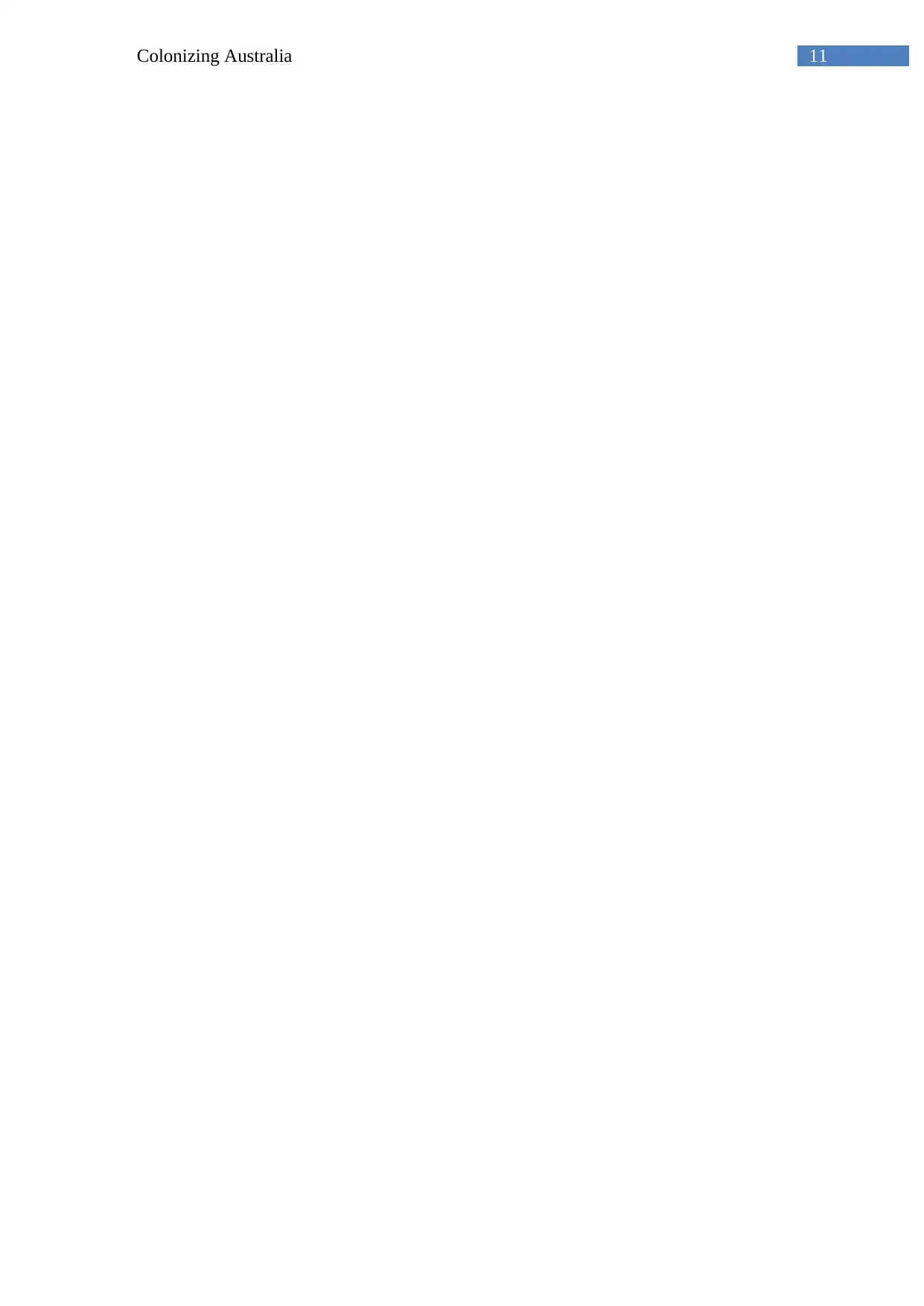
11Colonizing Australia
⊘ This is a preview!⊘
Do you want full access?
Subscribe today to unlock all pages.

Trusted by 1+ million students worldwide
1 out of 12
Related Documents
Your All-in-One AI-Powered Toolkit for Academic Success.
+13062052269
info@desklib.com
Available 24*7 on WhatsApp / Email
![[object Object]](/_next/static/media/star-bottom.7253800d.svg)
Unlock your academic potential
Copyright © 2020–2025 A2Z Services. All Rights Reserved. Developed and managed by ZUCOL.





